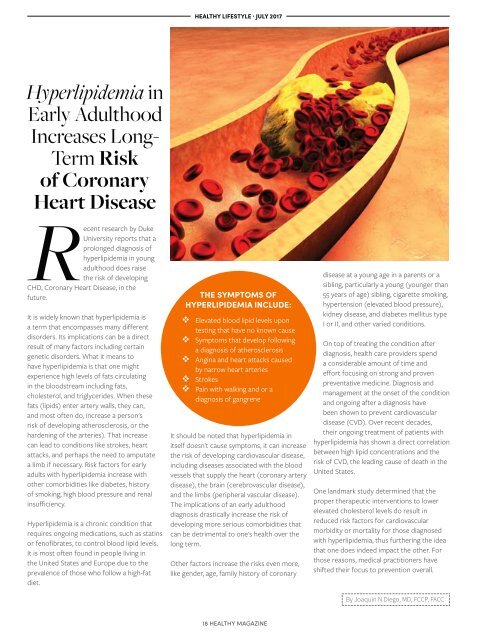Healthy SoFlo Issue 50
Create successful ePaper yourself
Turn your PDF publications into a flip-book with our unique Google optimized e-Paper software.
HEALTHY LIFESTYLE · JULY 2017<br />
Hyperlipidemia in<br />
Early Adulthood<br />
Increases Long-<br />
Term Risk<br />
of Coronary<br />
Heart Disease<br />
Recent research by Duke<br />
University reports that a<br />
prolonged diagnosis of<br />
hyperlipidemia in young<br />
adulthood does raise<br />
the risk of developing<br />
CHD, Coronary Heart Disease, in the<br />
future.<br />
It is widely known that hyperlipidemia is<br />
a term that encompasses many different<br />
disorders. Its implications can be a direct<br />
result of many factors including certain<br />
genetic disorders. What it means to<br />
have hyperlipidemia is that one might<br />
experience high levels of fats circulating<br />
in the bloodstream including fats,<br />
cholesterol, and triglycerides. When these<br />
fats (lipids) enter artery walls, they can,<br />
and most often do, increase a person's<br />
risk of developing atherosclerosis, or the<br />
hardening of the arteries). That increase<br />
can lead to conditions like strokes, heart<br />
attacks, and perhaps the need to amputate<br />
a limb if necessary. Risk factors for early<br />
adults with hyperlipidemia increase with<br />
other comorbidities like diabetes, history<br />
of smoking, high blood pressure and renal<br />
insufficiency.<br />
Hyperlipidemia is a chronic condition that<br />
requires ongoing medications, such as statins<br />
or fenofibrates, to control blood lipid levels.<br />
It is most often found in people living in<br />
the United States and Europe due to the<br />
prevalence of those who follow a high-fat<br />
diet.<br />
THE SYMPTOMS OF<br />
HYPERLIPIDEMIA INCLUDE:<br />
<br />
Elevated blood lipid levels upon<br />
testing that have no known cause<br />
<br />
Symptoms that develop following<br />
a diagnosis of atherosclerosis<br />
<br />
Angina and heart attacks caused<br />
by narrow heart arteries<br />
<br />
Strokes<br />
<br />
Pain with walking and or a<br />
diagnosis of gangrene<br />
It should be noted that hyperlipidemia in<br />
itself doesn't cause symptoms, it can increase<br />
the risk of developing cardiovascular disease,<br />
including diseases associated with the blood<br />
vessels that supply the heart (coronary artery<br />
disease), the brain (cerebrovascular disease),<br />
and the limbs (peripheral vascular disease).<br />
The implications of an early adulthood<br />
diagnosis drastically increase the risk of<br />
developing more serious comorbidities that<br />
can be detrimental to one's health over the<br />
long term.<br />
Other factors increase the risks even more,<br />
like gender, age, family history of coronary<br />
disease at a young age in a parents or a<br />
sibling, particularly a young (younger than<br />
55 years of age) sibling, cigarette smoking,<br />
hypertension (elevated blood pressure),<br />
kidney disease, and diabetes mellitus type<br />
I or II, and other varied conditions.<br />
On top of treating the condition after<br />
diagnosis, health care providers spend<br />
a considerable amount of time and<br />
effort focusing on strong and proven<br />
preventative medicine. Diagnosis and<br />
management at the onset of the condition<br />
and ongoing after a diagnosis have<br />
been shown to prevent cardiovascular<br />
disease (CVD). Over recent decades,<br />
their ongoing treatment of patients with<br />
hyperlipidemia has shown a direct correlation<br />
between high lipid concentrations and the<br />
risk of CVD, the leading cause of death in the<br />
United States.<br />
One landmark study determined that the<br />
proper therapeutic interventions to lower<br />
elevated cholesterol levels do result in<br />
reduced risk factors for cardiovascular<br />
morbidity or mortality for those diagnosed<br />
with hyperlipidemia, thus furthering the idea<br />
that one does indeed impact the other. For<br />
those reasons, medical practitioners have<br />
shifted their focus to prevention overall.<br />
By Joaquin N Diego, MD, FCCP, FACC<br />
18 HEALTHY MAGAZINE

















